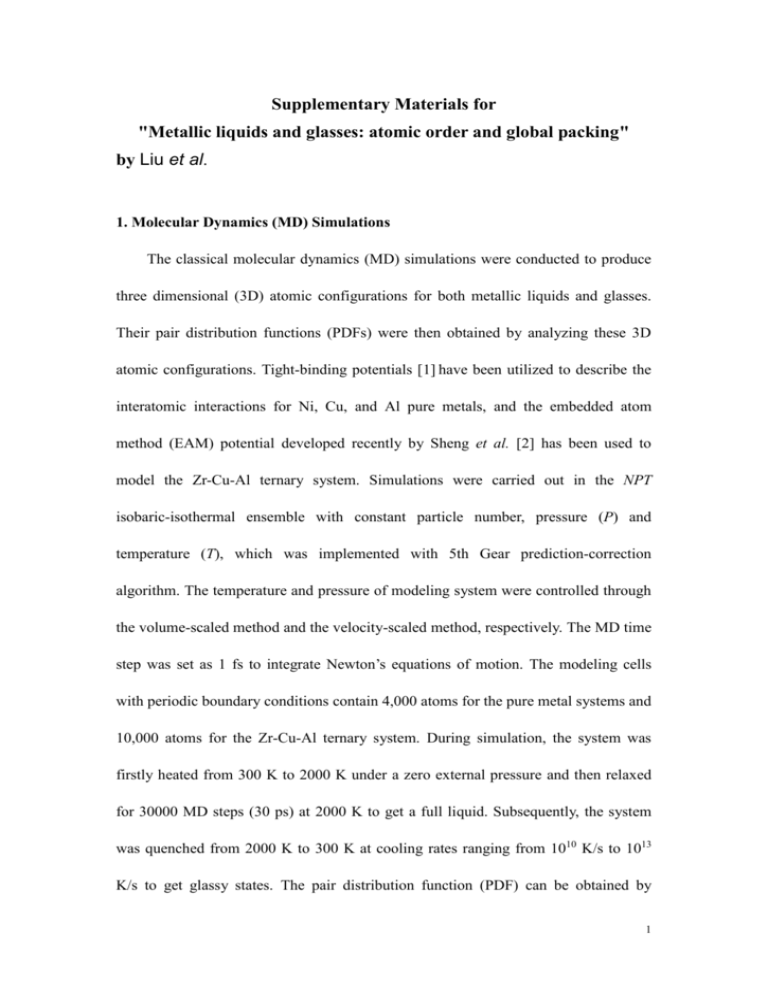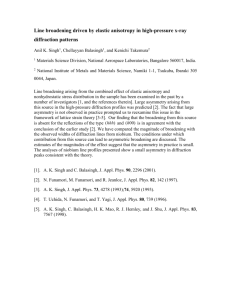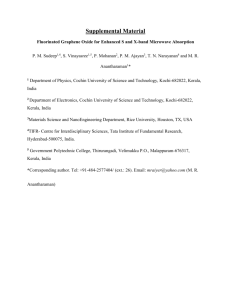Supplementary_Material-last-Liu
advertisement

Supplementary Materials for "Metallic liquids and glasses: atomic order and global packing" by Liu et al. 1. Molecular Dynamics (MD) Simulations The classical molecular dynamics (MD) simulations were conducted to produce three dimensional (3D) atomic configurations for both metallic liquids and glasses. Their pair distribution functions (PDFs) were then obtained by analyzing these 3D atomic configurations. Tight-binding potentials [1] have been utilized to describe the interatomic interactions for Ni, Cu, and Al pure metals, and the embedded atom method (EAM) potential developed recently by Sheng et al. [2] has been used to model the Zr-Cu-Al ternary system. Simulations were carried out in the NPT isobaric-isothermal ensemble with constant particle number, pressure (P) and temperature (T), which was implemented with 5th Gear prediction-correction algorithm. The temperature and pressure of modeling system were controlled through the volume-scaled method and the velocity-scaled method, respectively. The MD time step was set as 1 fs to integrate Newton’s equations of motion. The modeling cells with periodic boundary conditions contain 4,000 atoms for the pure metal systems and 10,000 atoms for the Zr-Cu-Al ternary system. During simulation, the system was firstly heated from 300 K to 2000 K under a zero external pressure and then relaxed for 30000 MD steps (30 ps) at 2000 K to get a full liquid. Subsequently, the system was quenched from 2000 K to 300 K at cooling rates ranging from 1010 K/s to 1013 K/s to get glassy states. The pair distribution function (PDF) can be obtained by 1 following formula: g (r ) L3 N N n (r ) 4r 2 dr , 1 (S1) where L is the box size and N is the number of particles. 2. Materials Fabrication Master ingots with nominal compositions were prepared by arc melting under a Ti-gettered argon atmosphere with pure metals (≥99.9%, wt%) as charge materials. Zr38.2Cu61.8, Zr44Cu56, Zr66.7Ni33.3 and Zr40Cu55Al5 (at. %) amorphous ribbons with a cross-section of 0.044 mm2 used for PDF analyses were produced by a melt-spinning technique under argon atmosphere. Amorphous nature of the samples was ascertained by X-ray diffraction (XRD) (see Fig. S1). 3. Pair distribution function (PDF) analysis Synchrotron X-ray scattering experiments were performed at beamline 11-ID-C of Advanced Photon Source at Argonne National Laboratory, using synchrotron radiation of energy of 115.381 keV (λ=0.10748 Å). A two dimensional image plate detector (MAR345) was used to collect data over a wide Q range (Q=4πsinθ/λ). The measurement of each sample was repeated five times. X-ray diffraction data of an empty capillary were also collected at the same experimental condition for background corrections. The corresponding images were subjected to geometrical corrections, integrated, and reduced to one-dimensional scattering intensity, I(Q) using the program FIT2D, which were further converted into absolute electron units, 2 and reduced to the total scattering structure function, S(Q), using the program PDFGETX2 [3]. The Fourier transformation of S(Q) yields the pair distribution function (PDF), g(r) (Fig. S2): g (r ) 1 1 2 2 0 Q[S (Q) 1]sin( Qr )d (Q) , 0 (S2) where ρ0 is the average number density and Q is the magnitude of the scattering vector. The peak position (Ri) was obtained by fitting the corresponding peak using Gaussian function. For instance, the R2 and R3 (see Fig. S2) were determined by fitting the splitting second peak in the g(r) with two overlapping Gaussian functions. 4. Effects of different radiation resources on PDF The experimental PDFs in literature were obtained by Fourier transformation of total interference functions derived from raw scattering data. Therefore, magnitude for each hidden partial PDF (in the case of multicomponent systems) depends on atomic scattering factor for the individual radiation source. In other words, weighting factors related to atomic scattering factors should be considered to analyze the experimental total PDFs. To clarify effects of different radiation resources on the total PDFs, we have compared the PDFs by introducing atomic scattering factors in a Zr46Cu46Al8 model MG. Firstly, we obtained the partial PDFs of the Zr46Cu46Al8 MG by MD simulations (Fig. S3). Secondly, we calculated the atomic scattering factors for X-ray, electron and neutron radiation sources, respectively. Based on the atomic scattering factor data, the weighting factors (Table S2) for each radiation source by the following formula were calculated [4]: 3 wij ci c j f i f j ci f i i 2 (S3), where ci is the concentration of element i, fi is the atomic scattering factor. Then, the total PDF can be obtained by the weighted sum of the partial PDFs: g ( r ) wij gij ( r ) i (S4). j The PDF profile (Fig. S4) is slightly changed with different radiation resources, but in principle, R2 and R3 are not strongly affected by the radiation resources. This is because R2 and R3 are atomic pair distances for short-range orders (SROs), which are not affected by radiation resources. Nevertheless, due to the broadening effect of the peak width, to a certain degree, experimentally measured Ri may be influenced by the radiation resources. However, this influence should not strongly affect the global feature, i.e., effects of the radiation sources on the ratios of Ri/R1 are ignorable. For example, there is an additional peak locating at ~3.10 Å on the PDF curve from the electron radiation in addition to the first peak locating at ~2.84 Å observed for all the three radiation resources (Fig. S4). Taking the partial PDF curves (Fig. S3) and the weight partial functions (Table S2) into account, we know that the Zr-Cu atomic pair (the distance of 2.83 Å, which is determined from the Fig. S3) is the major contribution to the first peak, and the Zr-Zr atomic pair (3.17 Å) is related to the additional peak. From the SRO viewpoint, the Zr-Cu atomic pair should be more predominant than Zr-Zr atomic pair in the Zr46Cu46Al8 MG. Therefore, the first peak, which represents the predominant SROs and reflects the global feature of MGs, is selected as R1 in this case. Accordingly, we can determine the R2 and R3 value. Indeed, 4 the similar results can also be found in Ref. 5. 5 Table S1. The first peak position R1 on the PDF patterns and the Ri/R1 (i=1,2,…,5) ratios for a variety of metallic glasses determined from diffraction measurements and molecular dynamic simulations. Metallic glass R1 R2/R1 R3/R1 R4/R1 R5/R1 References Cu* Ni* Al* Zr38.2Cu61.8† Zr44Cu56† Zr66.7Ni33.3* Zr40Cu55Al5† Zr50Cu50† Zr35.5Cu64.5* Zr66Ni34* Zr65Cu27.5Al7.5# Zr55Cu35Al10†# Zr46Cu46Al8† Zr65Ni25Al15* Zr52.5Cu17.9Ni14.6Al10Ti5†# Zr52Al6Cu14Ni8Fe20† Zr44.5Al10Cu20Ni8 Ti7.5† Zr57Al10Cu20Ni8 Ti5† Zr58Al10Cu20Ni8 Ti4† Zr59Al10Cu20Ni8 Ti3† Zr60Al10Cu20Ni8 Ti2† Zr41Ti14Cu12.5Ni10Be22.5** Cu40Ag60* Cu30Ag70* Cu60Hf30Ti10† Cu60Zr30Ti10† Cu60Ti20Zr20* Cu55Hf25Ti15Pd5† Cu47Ti33Zr11Ni8Si1† Fe50Al50* Fe75B25†# Fe81B19†# Fe86B14†# Fe83P17* Fe84B16* Fe82B18† Fe82Nb18† Fe82B15Nb3† Fe82B12Nb6† Fe82B9Nb9† Fe82B6Nb12† Fe82B3Nb15† Fe90Zr7B3# Fe80P13C7† 2.51 2.47 2.85 2.76 2.78 2.93 2.79 2.94 2.75 2.78 3.07 2.91 2.94 2.98 2.85 2.97 3.04 3.11 3.11 3.11 3.12 2.72 2.73 2.81 2.84 2.69 2.66 2.74 2.75 2.53 2.42 2.48 2.55 2.54 2.54 2.57 2.57 2.57 2.57 2.57 2.57 2.54 2.50 2.55 1.73 1.73 1.75 1.73 1.74 1.73 1.74 1.69 1.73 1.74 1.74 1.68 1.71 1.72 1.69 1.70 1.68 1.66 1.68 1.66 1.67 1.73 1.73 1.71 1.70 1.74 1.71 1.73 1.74 1.70 1.70 1.71 1.71 1.71 1.69 1.65 1.68 1.66 1.67 1.67 1.66 1.67 1.71 1.72 1.98 1.99 1.96 1.91 1.90 1.93 1.90 1.97 1.96 1.95 1.91 2.00 1.95 1.95 1.83 1.96 1.91 1.89 1.94 1.90 1.89 2.00 1.97 1.95 1.93 1.96 1.96 1.97 2.02 1.92 1.97 1.97 1.94 1.97 1.92 1.96 1.94 1.95 1.94 1.92 1.95 1.96 1.94 1.96 2.64 2.63 2.58 2.62 2.62 2.63 2.60 2.49 2.55 2.65 2.55 2.60 2.50 2.56 2.63 2.59 2.47 2.45 2.43 2.45 2.45 2.67 2.56 2.55 2.47 2.59 2.66 2.62 2.62 2.64 2.62 2.55 2.53 2.60 2.61 2.53 2.62 2.53 2.59 2.61 2.61 2.64 2.60 2.57 3.47 3.46 3.46 3.42 3.45 3.46 3.44 3.40 3.40 3.51 3.38 3.43 3.36 Present work Present work Present work Present work Present work Present work Present work [6] [7] [8] [9] [10, 11] [6] [12] [13] [14] [14] [14] [14] [14] [14] [15] [16] [17] [18] [18] [19] [20] [21] [22] [23] [23] [23] [24] [24] [25] [25] [25] [25] [25] [25] [25] [26] [27] 3.39 3.32 3.27 3.29 3.30 3.28 3.57 3.39 3.57 3.51 3.50 3.49 3.41 3.38 3.39 3.43 3.34 3.47 3.38 3.42 3.44 3.45 3.48 3.48 3.46 6 Metallic glass R1 R2/R1 R3/R1 R4/R1 R5/R1 References Ni73.8P26.2† Ni76P24† Ni77.2P22.8† Ni78.9P21.1† Ni81.4P18.6† Ni50Al50* Ni66.7Al33.3* Pd80Si20† Pd30Ni50P20† Pd40Ni40P20† Pd50Ni34P16† Pd40Cu30Ni10P20† Al89La6Ni5# Al90Fe5Nb5† Al77.5Mn22.5† Al56Si30Mn14† Mn75P15C10† Re82Tb18† Re93V7* Re* 2.47 2.47 2.47 2.41 2.41 2.51 2.50 2.79 2.64 2.65 2.70 2.75 2.75 3.15 2.75 2.58 2.57 2.76 2.73 2.72 1.70 1.68 1.67 1.70 1.74 1.76 1.74 1.71 1.70 1.69 1.70 1.68 1.70 1.74 1.72 1.70 1.73 1.68 1.68 1.69 1.93 1.94 1.93 1.96 2.00 1.96 1.94 1.94 1.91 1.91 1.96 1.92 1.92 2.04 1.95 2.02 1.95 1.93 1.95 1.95 2.61 2.61 2.59 2.63 2.63 2.64 2.62 2.58 2.55 2.54 2.51 2.54 2.69 2.47 2.46 2.52 2.59 2.57 2.62 2.62 3.46 3.46 3.44 3.51 3.51 3.49 3.44 [27] [27] [27] [27] [27] [28] [29] [27] [30] [30] [30] [31] [32] [33] [34] [34] [35] [36] [36] [36] 3.37 3.36 3.38 3.37 3.64 3.33 3.47 3.44 3.37 3.41 3.43 †: Synchrotron X-ray diffraction; Electron diffraction; †#: Neutron diffraction; *: Molecular dynamics; **: ab initio molecular dynamics. #: Table S2: Weight partial functions wij for different radiation sources in the Zr46Cu46Al8 model system Partial function X-ray Electron Neutron wZr-Zr 0.31499 0.41899 0.214 wZr-Cu 0.45688 0.38602 0.46135 wZr-Al 0.03562 0.07059 0.03585 wCu-Cu 0.16567 0.08891 0.24865 wCu-Al 0.02583 0.03252 0.03865 wAl-Al 0.00101 0.00297 0.0015 7 Figure S1: The typical XRD patterns for as-cast amorphous ribbons. Intensity (a.u.) Zr38.2Cu61.8 Zr44Cu56 Zr66.7Ni33.3 30 40 50 60 2 (deg.) 70 80 8 Figure S2: Typical g(r) curves obtained from synchrotron X-ray diffraction experiments for Zr-Cu-(Al) MGs. The dash lines illustrate schematically the peak positions. Zr38.2Cu61.8 Zr40Cu55Al5 R2 R 3 R5 g(r) R4 R1 2 3 4 5 6 7 r (Å) 8 9 10 11 9 Figure S3: Calculated partial PDF curves of the Zr46Cu46Al8 model system by MD simulations. Partial PDF Zr-Zr Zr-Cu Zr-Al Cu-Cu Cu-Al Al-Al 0 2 4 6 8 r (Å) 10 Figure S4: PDF curves obtained from different radiation sources in the Zr46Cu46Al8 model system. Zr46Cu46Al8 PDF X-ray Electron Neutron 2 4 6 8 r (Å) 10 12 14 10 References [1] F. Cleri, and V. Rosato, Phys. Rev. B 48, 22 (1993). [2] Y. Q. Cheng, E. Ma, and H. W. Sheng, Phys. Rev. Lett. 102, 245501 (2009). [3] X. Qiu, J. W. Thompson, and S. J. L. Billinge, J. Appl. Cryst. 37, 678 (2004) [4] N. Mattern et al., Acta Mater. 50, 305 (2002). [5] D. Ma, A. D. Stoica, X. L. Wang, Z. P. Lu, M. Xu, and M. Kramer, Phys. Rev. B 80, 014202(2009). [6] X. D.Wang, et al. J. Appl. Phys. 104 , 093519 (2008). [7] M. I. Mendelev, D. J. Sordelet, and M. J. Kramer, J. Appl. Phys. 102 , 043501 (2007). [8] A. Takeuchi, et al., Intermetallics 16, 774 (2008). [9] H. Schumacher, et al., J. Appl. Phys. 82 , 155 (1997). [10] C. Fan, et al., Intermetallics 14, 888 (2006). [11] C. Fan, et al., Appl. Phys. Lett. 89 , 231920 (2006). [12] M. Guerdane, and H. Teichler, Phys. Rev. B 65, 014203 (2001). [13] W. Dmowski, et al., Mater. Sci. Eng. A 471, 125 (2007). [14] N. Mattern, et al., Acta Mater. 50, 305 (2002). [15] X. Hui, et al., Acta Mater. 57, 376 (2009). [16] Y. Qi, et al., Phys. Rev. B 59, 3527 (1999). [17] H. W. Sheng, J. H. He, and E. Ma, Phys. Rev. B 65, 184203 (2002). [18] M. Kasai, et al., J. Phys.: Condens. Matter 14, 13867 (2002). [19] X. J. Han, and H. Teichler, Phys. Rev. E 75, 061501 (2007) 11 [20] D. V. Louzguine-Luzgin, et al., Appl. Phys. Lett. 88, 121926 (2006). [21] J. Bednarcik, et al., Mater. Sci. Eng. A 498, 335 (2008). [22] H. Li, et al., Phys. Lett. A 280, 325 (2001). [23] E. Sváb, et al., J. Phys. Colloques 46, C8-267 (1985). [24] A. V. Evteev, A. T. Kosilov, and E. V. Levtchenko, Acta Mater. 51, 2665 (2003). [25] M. Yamada, Y. Terashima, and K. Tanaka, Mater. Trans., JIM 34, 895 (1993). [26] T. Ohkubo, et al., Mater. Sci. Eng. A 312, 274 (2001). [27] G. S. Cargill III, J. Appl. Phys. 41, 12 (1970). [28] L. Wang, X. F. Bian, and J. X. Zhang, Modelling Simul. Mater. Sci. Eng. 10, 331 (2002). [29] H. Li, F., Ding, X. F. Bian, and G. H. Wang, Chem. Phys. Lett. 354, 466 (2002). [30] T. Egami, et al., Metall. Mater. Trans. A 29, 1805 (1998). [31] N. Mattern, U. Kuhn, and J. Eckert, J. Non-Cryst. Solids 353, 3327 (2007). [32] G. Li, et al., Acta Mater. 57, 804 (2009). [33] E. Pineda, et al., J. Non-Cryst. Solids 354, 5140 (2008). [34] E. Matsubara, et al., J. Mater. Sci. 23, 753 (1988). [35] A. K. Sinha, and P. Duwez, J. Appl. Phys. 43, 431 (1972). [36] Y. V. Barmin, et al., J. Phys.: Condens. Matter 20, 114117 (2008). 12





